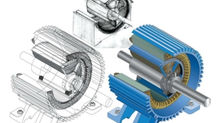Construction and service life of GIS
GIS is assembled of standard equipment modules (circuit breaker, current transformers, voltage transformers, disconnect and ground switches, interconnecting bus, surge arresters, and connections to the rest of the electric power system) to match the electrical one-line diagram of the substation. A crosssection view of a 242-kV GIS shows the construction and typical dimensions (Figure 2.1). The modules are joined using bolted flanges with an “O” ring seal system for the enclosure and a sliding plug-in contact for the conductor. Internal parts of the GIS are supported by cast epoxy insulators.
These support insulators provide a gas barrier between parts of the GIS, or are cast with holes in the epoxy to allow gas to pass from one side to the other.

Figure 2.1 Single-phase enclosure GIS
Up to about 170 kV system voltage, all three phases are often in one enclosure (Figure 2.2). Above 170 kV, the size of the enclosure for “three-phase enclosure,” GIS becomes too large to be practical. So a “single-phase enclosure” design (Figure 2.1) is used. There are no established performance differences between three-phase enclosure and single-phase enclosure GIS. Some manufacturers use the single-phase enclosure type for all voltage levels.
Enclosures today are mostly cast or welded aluminum, but steel is also used. Steel enclosures are painted inside and outside to prevent rusting. Aluminum enclosures do not need to be painted, but may be painted for ease of cleaning and a better appearance. The pressure vessel requirements for GIS enclosures are set by GIS standards (IEEE Std. C37.122-1993; IEC, 1990), with the actual design, manufacture, and test following an established pressure vessel standard of the country of manufacture.
Because of the moderate pressures involved, and the classification of GIS as electrical equipment, third-party inspection and code stamping of the GIS enclosures are not required.
Conductors today are mostly aluminum. Copper is sometimes used. It is usual to silver plate surfaces that transfer current. Bolted joints and sliding electrical contacts are used to join conductor sections.
There are many designs for the sliding contact element. In general, sliding contacts have many individually sprung copper contact fingers working in parallel. Usually the contact fingers are silver plated. A contact lubricant is used to ensure that the sliding contact surfaces do not generate particles or wear out over time. The sliding conductor contacts make assembly of the modules easy and also allow for conductor movement to accommodate the differential thermal expansion of the conductor relative to the enclosure.
Sliding contact assemblies are also used in circuit breakers and switches to transfer current from the moving contact to the stationary contacts. Support insulators are made of a highly filled epoxy resin cast very carefully to prevent formation of voids and/or cracks during curing. Each GIS manufacturer’s material formulation and insulator shape has been developed to optimize the support insulator in terms of electric field distribution, mechanical strength, resistance to surface electric discharges, and convenience of manufacture and assembly. Post, disc, and cone type support insulators are used. Quality assurance programs for support insulators include a high voltage power frequency withstand test with sensitive partial discharge monitoring.
Experience has shown that the electric field stress inside the cast epoxy insulator should be below a certain level to avoid aging of the solid dielectric material. The electrical stress limit for the cast epoxy support insulator is not a severe design constraint because the dimensions of the GIS are mainly set by the lightning impulse withstand level and the need for the conductor to have a fairly large diameter to carry to load current of several thousand amperes. The result is space between the conductor and enclosure for support insulators having low electrical stress.

Figure 2.2 Three-phase enclosure GIS
Service life of GIS using the construction described above has been shown by experience to be more than 30 years. The condition of GIS examined after many years in service does not indicate any approaching limit in service life.
Experience also shows no need for periodic internal inspection or maintenance
Inside the enclosure is a dry, inert gas that is itself not subject to aging. There is no exposure of any of the internal materials to sunlight. Even the “O” ring seals are found to be in excellent condition because there is almost always a “double seal” system — Figure 2.3 shows one approach.

Figure 2.3 Gas seal for GIS enclosure
The lack of aging has been found for GIS, whether installed indoors or outdoors.
SOURCE: Gas-Insulated Substations BY Philip Bolin Mitsubishi Electric Power































